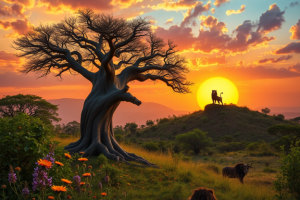
Lake Tana and its wetlands provide an invaluable habitat for the truly spectacular and unique birdlife that flourishes around the lake. Located in the Horn of Africa, it is a key location for birds migrating between Europe, Asia and Africa. More than 300 bird species have been recorded around Lake Tana, many of which are a must-see for an intrepid bird enthusiast.
Flocks of Great White Pelicans gliding across the lake’s surface are a sight visitors cannot fail to enjoy. These birds live here in abundance thriving on the fish stocks of the lake, and are real show-pieces for the lake’s peaceful and serene character. Rare and endangered bird species such as the stately Black-crowned Crane and the elegant Wattled Crane live in the agricultural landscape and wetlands around the lake. Both bird species stand over one meter tall and their beautiful courtship dances are a sight to behold.
Watching the vividly-colored Half-collared Kingfisher as it gracefully skims the lake’s surface is yet another delight for bird-lovers. African Fish Eagles perch in tall trees overlooking the lake, their keen eyes ready to swoop and grab their next meal with their talons. Another hidden gem for any bird-enthusiast is a sighting of the elusive Yellow-fronted Parrot. The Zege Peninsula is one of the best places to spot this green parrot with its starkly contrasting yellow head. If you look up into the canopy of the sacred church forests you may be able to catch a glimpse of this beautiful bird, which is endemic to the Ethiopian Highlands.
The inconspicuous and some may say, rather drab-looking White-throated Seedeater is a small bird that is on the list of many a twitchier. It is an endemic species found only in the north of Ethiopia and Eritrea and can be spotted in small groups in the area. Lake Tana is the largest national freshwater body, accounting for 50 percent of the total inland waters of the country, and is the source of the Abbay of Blue Nile River. The Biosphere Reserve is an important fish resource and is home to up to 67 different species of fish of which 70 percent are endemic.
Tana constitute the only remaining intact species of large cyprinid fish in the world. A large number of wetlands are located all around Lake Tana, some of them being the largest and ecologically most important units in Ethiopia and in the Horn of Africa, and also form part of the Central Ethiopian Wetland Complex. These wetlands, dominated by papyrus and typha stands, are breeding, nesting and feeding grounds for very large bird populations, and provide a source of animal feed, domestic water supply, building material, fuel, food, etc. for local communities.
The Biosphere Reserve is part of the Eastern Afromontane Biodiversity Hotspot and comprises four terrestrial and three freshwater ‘Key Biodiversity Areas’. At Lake Tana more than 217 different bird species have been recorded. The area is internationally renowned as Important Bird Area and the high abundances qualify areas around the lake as Ramsar site. Many Palaearctic migrant water birds depend on the lake as feeding and resting grounds, including the common crane (Grus grus), Northern shoveller (Anas acuta), Black-tailed godwit (Limosa limosa), and ruff (Philomachus pugnax). Few patches of original forest vegetation and mountain ecosystem remain that have high plant endemism of global importance.
Indigenous trees include: Sesa (Albizia gummifera), Birbira (Millettia ferryginea), Wanza (Cordia Africana). The region is a gene center for indigenous agricultural crops such as noug (Guizotia abyssinica), teff (Eragrostis teff). Wild coffee (Coffea arabica) occurs naturally in the area, especially in the Zegie Peninsula. Four major wetland ecosystem types have been identified: Riverine freshwater wetlands, lacustrine freshwater wetlands, palustrine freshwater wetlands and agricultural flooded freshwater wetlands.
Out of the 2,031,820 inhabitants of the proposed site, approximately 15,000 are living on the islands of Lake Tana. The area includes an array of rural settlements, as well as the city of Bahir Dar, which supports traditional land-use patterns. Agriculture (of which most is subsistence farming) forms the backbone of the economy with most of the other sectors (i.e. trade, fishing and tourism) being dependent on its strong backward and forward linkages. More than two million people live in the Biosphere Reserve with the Amhara people being the most populous in the area.
The main economic activities are agriculture, fishing, national and international tourism (religious and recreational) and sand mining. The enhancement of production and marketing of local products from the proposed biosphere reserve through cooperatives and small scale businesses will be intensified in close collaboration with local tourism services and the hotel sector. The Papyrus (Cyperus papyrus) is one the most economically important wetland species of the Biosphere Reserve and is used inter alia for fuel, as well as for the construction of the unique Tanqua reed boats.
The area has a unique cultural, historical and aesthetic value with numerous monasteries and churches dating back to the 13th century. Culturally, the Biosphere Reserve is very important as it is home to many unique churches and monasteries of the Ethiopian Orthodox Tewahedo Church; some date back to the 13th century. These churches and monasteries contain valuable treasures of the Ethiopian Christian faith.
COMPILED BY LAKACHEW ATINAFU
The Ethiopian Herald May 7/2021





